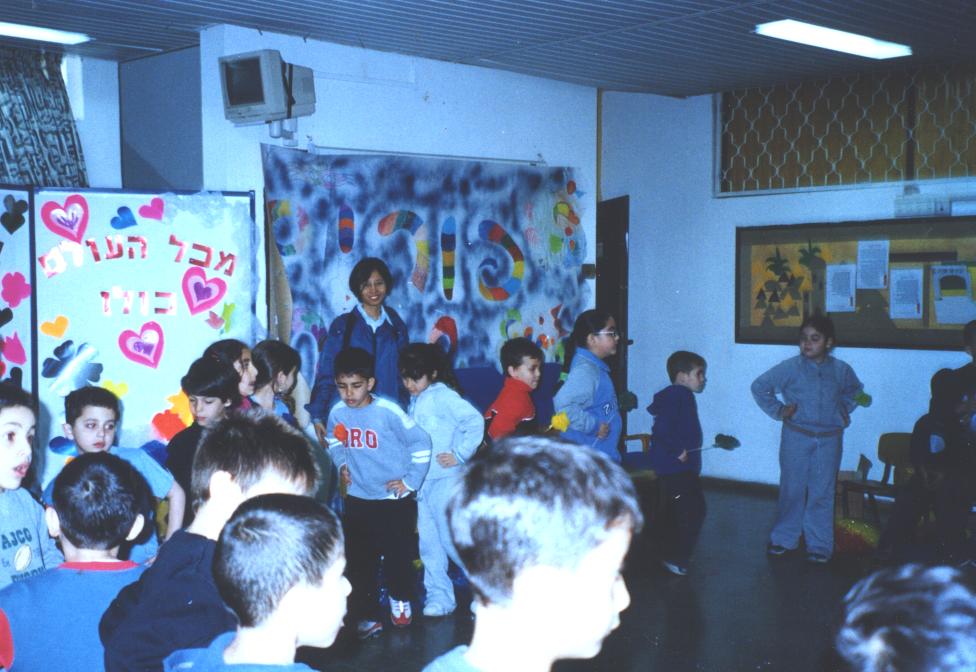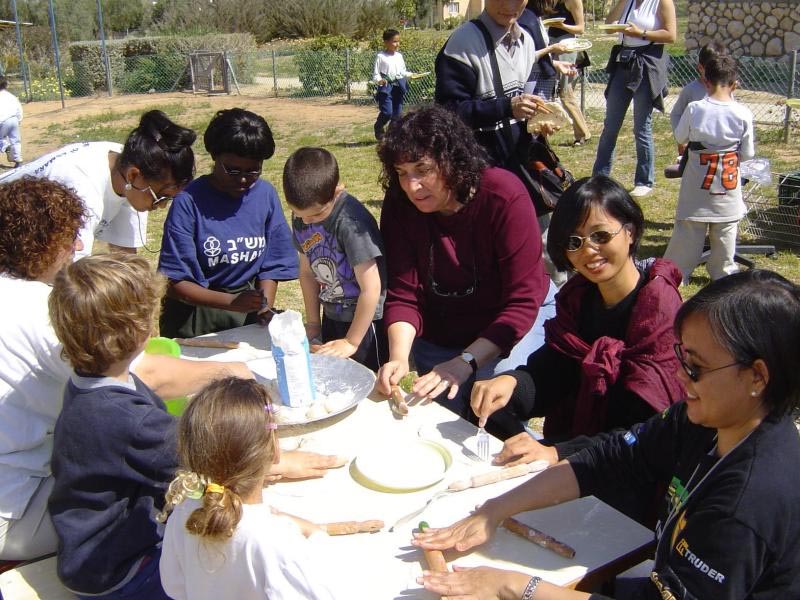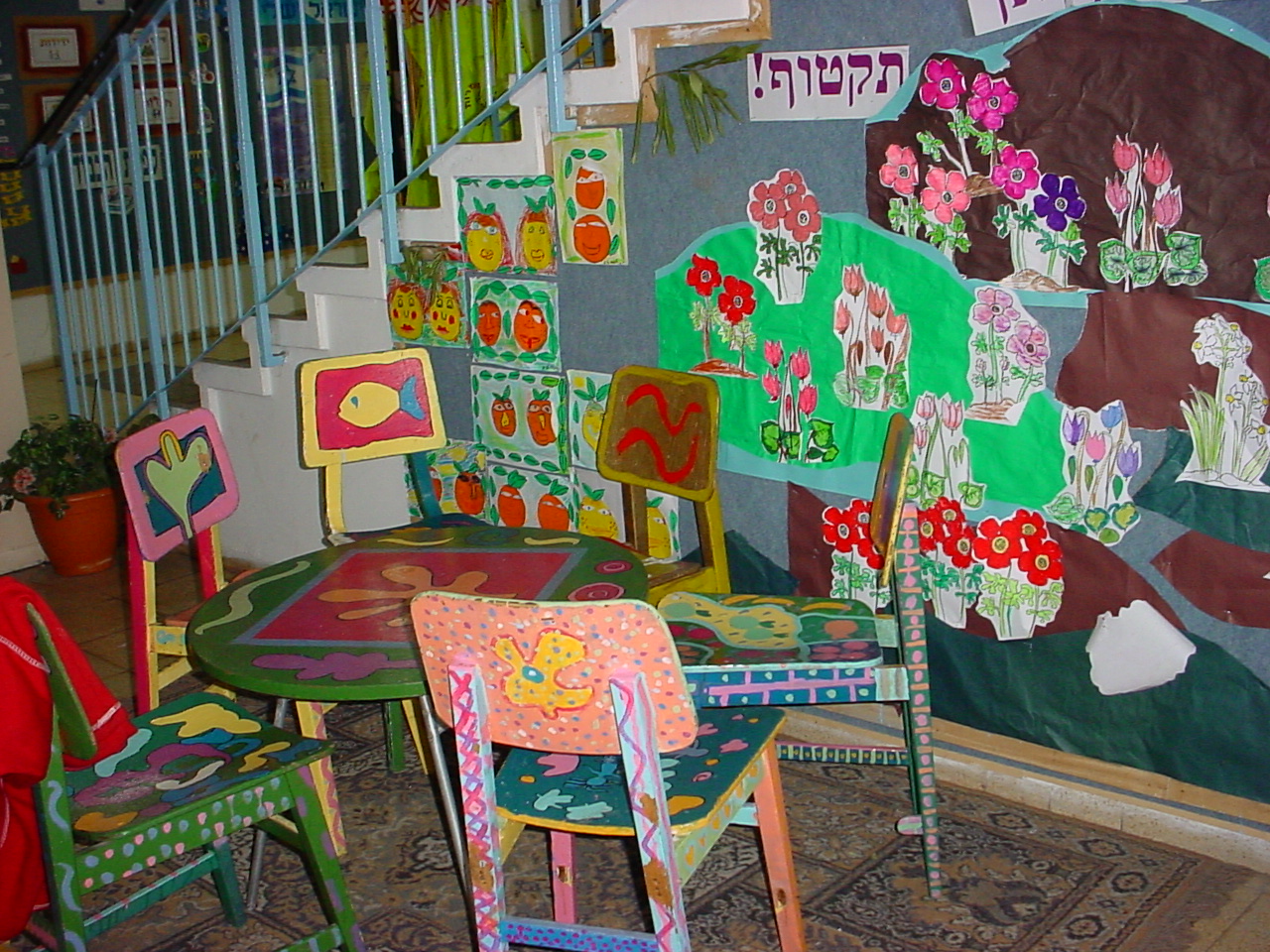 
|

Learning About The Sucess For All Reading Program
|
Ms. Dalia Firman warmly welcomed
us to her school in ACCO on March 14, 2004. They prepared a program for us, a handsome boy with an eyeglasses and a pretty
girl in hanging blouses played a very beautiful violin piece for us. The towns mayor who was there because Ms. Dahlia wanted
us to understand how his support make her projects viable was also there to give a beautiful message to us about the importance
of education, community support and all that. Ms. Dahlia told us that Snazar school catered to the very affluent families
as well as the poor ones. She said that what one group lack was somehow balanced by the other, thus, they benefited from each
others experience. She also told us that Snazar school offered two shifts, the first one in the morning was for the regular
children and the second one was the classes taught by volunteers, teachers, parents and people from the community, they offered
music classes and other special interest classes for interested children. They had a buddy system wherein an older child would
be partnered to a younger child during their free time. Each of them would read to each other thus, the younger childs reading
skill would improve. They had a new library that was newly built from all the generosity of people who supported the school.
They implemented teaching English as early as Grade I in that school, and only experts were able to teach, because Ms. Dalia
firmly believed that she has to offer the best to the schools populace. |
|
|
After the school visit
we had our falafel lunch at the seaside. I wanted to feel the sand on my feet so I went down on the steps but the wind was
too fierce for me, and there were a lot of stones with the sands that I was afraid I might cut myself on something if I persisted. I went to join Besy and Ms. Shirley on the shade after I got my falafel but it was
to cold for me, I quiver like an exposed leaf in a branch, I tried turning my back on the wind but I was still trembling because
of the cold so I joined Hanna, Aneta and Mr Kien and ate my food under the sun. I
was not able to finish my lunch on the time allotted for us to eat our food though so as usual I finished my food on the bus
while we were going to the starting point of our unscheduled tour of Acco.

|
| Baking pita bread with the preschool children |
Visiting
a Kindergarten In Kibbutz Tlalim
We get off at the Jewish Agency Department of Immigration
and Absorption in Negev and walked to the kindergarten
in Kibbutz Tlalim. Like the other school that we had visited before, the walls of the classroom were decorated with visuals
and childrens works depicting spring and the coming Pesak or the Passover.
The children were in the back
enthusiastically baking pita bread under the warm rays of the sun when we desultory arrived and they invited us to join them
in eating the bread. Some of our group joined not just in eating but in kneading the bread as well and had our picture taken
doing so.
|
|
 |
 |
 |
|
The MASHAV - MCTC Experience
|
 |
|
School Visits
|
 |
|
|
 |
 |
|
Want to learn about the how things are going on in Israel's school, just read on.
|
|
|
Appropriate
Intervention Suitable to the Learning Needs of the Child
There are different educational settings for different
kind of children in Israel.
For example, preschool children with language problems attend a kindergarten with the services of speech pathologist and occupational
therapist offering a multi-sensory program. In Netanyahu Kindergarten
, when the children came to school each of them looked for their names in the bulletin board and put it in the left
side of the board, they then walked, hopped along, jumped with both feet along or in a crisscrossed (left then right) pattern
along the length of the rope, then they jumped inside the three hoops laid end to end, one after the other on the floor. They
needed to say the letter beside the hoop as well as to give words associated with the initial sound of the letter to complete
this activity. After this, they picked an addition card from a box and showed each addends in each side of the vertical line
in the board provided for this activity by putting the correct number of bugs cutouts in each side, as well as saying the
sum of the addends based on what they did on the board, however they are only allowed to use one hand to do this activity,
they could use left or right hand depending on their preference but not both. After this activity, they rolled the dice with
a worldwide accepted symbol of position on each of its side to learn about preposition. When the symbol shows up, they would
pick a butterfly or a bird from the box and put it above a flower or a plant in the board provided for this activity, after
rolling on a mat. This activity resulted to a picture of spring that was put together by the children piece by piece, or flower
by flower, butterfly by butterfly, leaves by leaves, etc.
The second activity was circle time, specifically group singing. A child rolled the dice with letters on the
pockets of each of its side. After the child picked up the specific day of the week that starts with the letter shown on the
side of the dice that faced upwards, she would stick the word to the board that contains the a descriptive calendar.
There are also children whose emotional problems
cause language delays that they need to attend a special kindergarten for children with language difficulties like the Nufar
kindergarten in the city of Kiryat Motzkin, a kindergarten
in Haifa which has an adjacent kindergarten for regular children, the Savion kindergarten . The children
with language delays are mainstreamed in the regular class next door depending on their levels; some are integrated twice
a week while some joined the other class more frequently. The special education teacher of the special group would bring the
child to the teacher of the regular child along with the activity sheets, and the child would stay with the regular class
for a specific amount of time during that day.
We also visited Matia, a training and resource
center, designed for autistic children, a place where teachers are given their training during their free time as well as
a place where they could borrow or rent instructional materials. Matia provided services to 40 schools in Haifa. There
are 67 centers like MATIA throughout Israel according to Ms.
Annie Bogin, coordinator of Integrated Kindergartens.
Visiting A School For Autistic Children
Entering the OFER school gave me the sense of space, there were surely a lot
of choices, because to the left were the teachers lounge or a faculty room I think, Im not sure which but Ive seen staff heat
their food there, there was also a ref I think, aside from the conference table where we were told to wait, to the right were
offices of staff I think, I was not so sure, on the walls of these rooms were paintings, actual art work of the students in
this school, so they say, they told us that one of these painting actually won a third place in a national competition in
fact, but directly facing me at the entrance is the stairs going down to the
classrooms.
Aside from the usual therapy rooms found in other schools that Ive visited, this center has a room for
animal therapy where different pets like birds, and rabbits can be seen, as well as a indoor garden for plant therapy. The
school personnel that oriented us about the school told us that going to these room calms some of the children.
Visiting A Learning Disability Center
We visited the Learning Disability Center-Tirat
Carmel in Haifa that is supported by the regional resource center. They had a one way window in their
speech therapy room with a floor to ceiling maroon (or is it dark red?) curtain that hang in a semicircle curtain rod outside
the room, concealing the observer from the curious passerby in the corridor.
|
|
 |
|
|
We were able to observe children
lying in bean bags during a story telling session. We also saw two children coming to the art room and having the freedom
to do what they want thus expressing themselves through their art work. Apparently, the art therapist was just there to supervise
the children and not to direct their work. Without the pressure of expectation from adults, the children can unwind and for
a change dont need to concern themselves with the burden of having their work assessed, though unknowingly of course their
art work reflects their development as well as their emotions or inner self. I think it was very nice. |
|
|

The Genigar School
We visited Genigar School, an educational center that
caters to students with a variety of mental and physical developmental problems on Monday, March 22, 2004. Aside from offering the students sensory motor, emotional-behavioral, personal, cognitive-academic, social,
vocational, communication. The school assists the students to gain employment and be socially active exhibiting, self-esteem
and personal autonomy. They have different productivity rooms (jewelry, wood, textiles, ceramics, plastics) for the technology
workshops, where the childrens make products sold commercially. They had also video photography/stills photography, a radio
station, advertising, internet, animation and journalism in the school, in fact the students won a contest for a multimedia
production, a combination of video and animation application.
I've seen in the computer room that a teacher is using
the Microsoft Word to teach a child in putting circles inside a plate by pressing the up, down, left and right keys in the
keyboard. But what impressed me most from this visit is the Snooze Room or the Wonderland, where a child just come in based
on a once a week schedule I think, and do whatever they want. The child came in with a teacher or a therapist that wont direct
him/her in any way just observe his/or her activities or behavior to help him/her more in his/her lessons/therapies.
Visiting A Preschool Center for the Hearing Impaired
|
MICHA Haifa was established in 1967
with 25 teachers who did everything. MICHA stands for Society for Deaf and Dumb children in Hebrew and although we dont call
hearing impaired children deaf and dumb anymore the name of the center was already popular as such so the name stuck. The
Center serves Arab and Jewish children located in the north of the country. The center gives more speech therapy and occupational
therapy to children from 1 ½ to 5 years old.
They had very good screening process
in Israel
for hearing impaired children, since 95% of the children get to Tipat Halav. Sometimes identification was even done in hospitals
at birth since women who give birth in hospitals get insurance while women who didnt do so didnt get anything. After the hospitals
and the Tipat Halav, MICHA get to take care of the children.
MICHA Haifa has a teacher which
is its own student, a hard of hearing girl that is now taking up her second degree. Hearing her talk about her anger for most
of her life and her subsequent acceptance of life at this stage made me realize the extent of the frustrations of my former
students, because although I felt it from time to time during my four years of teaching hearing impaired children, I didnt
realize that they might bring the anger into their adult life. She informed us that she had just a cochlear implant about
a year ago which is just another form of hearing aid. She had to pay because although
children can have their hearing
aid as soon as they were fitted, because everything even cochlear implant is provided for free until the age of 18 in Israel, she had her operation when she was past 18. Still according her, a person that had
a cochlear implant had to undergo therapy too, and its only recommended to children with severely hearing impairment that
they would not benefited from a normal hearing aid. |
|
|
|
 |
|
|
|
|
|
